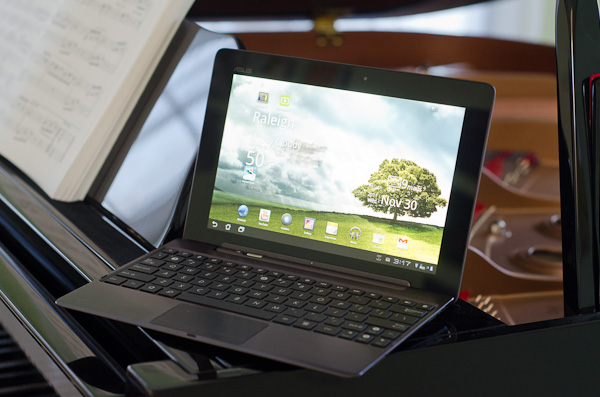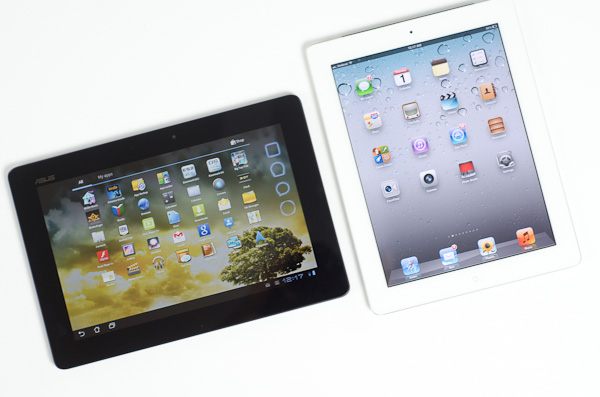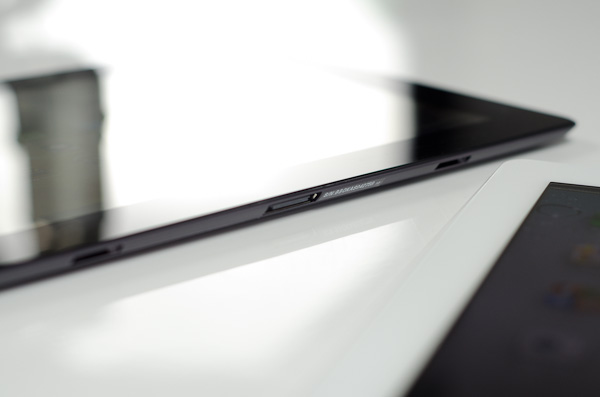ASUS Eee Pad Transformer Prime & NVIDIA Tegra 3 Review
by Anand Lal Shimpi on December 1, 2011 1:00 AM ESTGoing from making good motherboards to going head to head with Samsung for Google's affection is a pretty big step for ASUS, but it's one that the company has taken and done very well with. None of its peers have made the same transition, especially not while continuing to thrive in their existing businesses. I don't think anyone can say that ASUS' motherboards have suffered over the past several years as the company has transitioned, much like Apple, into the world of being a mobile computer manufacturer.
ASUS' first Android tablet was a knock out of the park. The original Eee Pad Transformer gave us a glimpse of the future with its keyboard dock while delivering a good Honeycomb experience for $100 less than the competition. As many sacrifices as ASUS had to make to reach its price point, the original Eee Pad remains one of the best Honeycomb tablets on the market. But the show must go on and simply being the cheapest on the block doesn't work anymore, particularly with companies like Amazon redefining what cheap means. It was time for a new flagship and today we have that tablet:
Priced at $499 the Eee Pad Transformer Prime will be available in North America during the week of 12/19.
| Tablet Specification Comparison | ||||||
| ASUS Eee Pad Transformer | ASUS Eee Pad Transformer Prime | Apple iPad 2 | Samsung Galaxy Tab 10.1 | |||
| Dimensions | 271mm x 175mm x 12.95mm | 263 x 180.8 x 8.3mm | 241.2 x 185.7 x 8.8mm | 256.6 x 172.9 x 8.6mm | ||
| Display | 10.1-inch 1280 x 800 | 10.1-inch 1280 x 800 Super IPS+ | 9.7-inch 1024 x 768 IPS | 10.1-inch 1280 x 800 PLS | ||
| Weight | 675g | 586g | 601g | 565g | ||
| Processor | 1GHz NVIDIA Tegra 2 (2 x Cortex A9) | 1.3GHz NVIDIA Tegra 3 (4 x Cortex A9) | 1GHz Apple A5 (2 x Cortex A9) | 1GHz NVIDIA Tegra 2 (2 x Cortex A9) | ||
| Memory | 1GB | 1GB | 512MB | 1GB | ||
| Storage | 16GB + microSD card | 32GB/64GB + microSD slot | 16GB | 16GB | ||
| Pricing | $399 | $499/$599 | $499 | $499 | ||
Whereas Motorola was first out of the gate with a Tegra 2 based Honeycomb tablet, ASUS is done with playing second fiddle. ASUS is NVIDIA's first and only launch partner for its new quad-core Tegra 3 SoC. The Google OS of choice is still Honeycomb, although I hear the Eee Pad Transformer Prime also happens to be Google's development and validation vehicle for Ice Cream Sandwich on Tegra 3.
The Prime is everything the original Eee Pad Transformer was missing. It's thinner than an iPad 2 or Galaxy Tab and built out of aluminum and glass. Other than minor details like the buttons and connectors, your hands never touch plastic when using the Transformer Prime. Even those plastic buttons look and feel great. The tablet is just beautiful. It echoes the design language of ASUS' Zenbook, but without the disappointment in the panel department. ASUS' latest tablet actually has the best display of any tablet we've reviewed, including those made by Apple and Samsung (more on this later).
The usual suspects are carefully placed around the perimeter of the Transformer Prime. Held in landscape mode the power/lock button is at the top left corner, with the volume rocker perpendicular to and just below it on the left side. Also along the left side is a micro HDMI output for display cloning and a microSD card slot. A standard 1/8" headset jack finds itself on the right side of the tablet, and ASUS' standard dock connector is bottom center. The original Eee Pad had two speaker grills, while the Prime has a single, larger speaker on the back of the device. Audio output is surprisingly full but the tablet doesn't get loud enough to overpower a noisy environment.
ASUS went a little crazy with the rubber stoppers all over the Prime. The dock connector and its two mechanical retention/secure points are plugged with these things, as is the USB port on the optional transformer dock.
Just like last time, the Eee Pad Transformer Prime can be mated to an optional keyboard dock for an extra $149. The dock adds a QWERTY keyboard, trackpad, an SD card reader, USB port and comes with its own 22Wh battery. The dock's battery not only powers itself but it can charge the Prime's battery, almost doubling battery life.
We'll spend the next several pages going through every detail of the new Eee Pad Transformer Prime as well as NVIDIA's Tegra 3 SoC, but on the surface, ASUS has built a formidable tablet. How does it fare under closer scrutiny? Very well it turns out...
A Lesson in How Not to Launch a Product
Of all of the things ASUS has learned from running the PC side of its business it seems that the proper way to launch a brand new platform didn't translate over to its tablet business. I received the Eee Pad Transformer Prime 39 hours ago and the NDA lifted just now. While this is not atypical for many mobile launches, ASUS should know better.
To do a thorough review of any product the minimum time we need to adequately integrate that product into our daily routine and come away with a deep understanding of the product is at least a week. I say that's the minimum amount of time because if you give us more, then we can do even better analysis and spend even more time bug hunting. Most of the players in the mobile space don't really get this, and as a result they are complicit in the disappointing amount of analysis that's done on their hardware. This will change as time goes on, but I honestly expected more from ASUS.
My WiFi is Broken
What's one of the biggest risks when you give reviewers only 39 hours to review a product? If something is wrong with the review sample, there's hardly any time to fix it. This time I drew the short straw and my Transformer Prime review sample arrived with highly questionable WiFi performance. Both range and performance were impacted by whatever plagued my sample. I got less range and much lower performance than the original Eee Pad Transformer regardless of location or wireless access point. How bad? My Prime had difficulty sustaining more than 2Mbps over WiFi. ASUS and NVIDIA both sent me proof that there wasn't something wrong with other samples, and from their data it looks like the WiFi stack in the Prime is at least comparable to the original Transformer. The problem may just be limited to my unit, although I tend to believe that if something goes wrong once, it's bound to go wrong more than once.
Based on the fact that wireless performance improves when docked and upstream speeds are almost normal, if I had to guess I'd say that the receive antenna is either not fully connected or somehow impaired from doing its normal duty. I should have a replacement unit in by tomorrow, but unfortunately that means you won't see any WiFi dependent results here.
ASUS chose Broadcom's BCM4329 for WiFi/Bluetooth duty. Although the controller supports both 2.4GHz and 5GHz operation, the Prime is limited to work on 2.4GHz networks. The rest of the design is pretty standard - you get a single spatial stream at a maximum of 72Mbps. Real world performance, if ASUS/NVIDIA's numbers are to be believed, should top out somewhere in the upper 30Mbps area.
Update: ASUS got us a fixed unit, be sure to check out our follow-up here.




















204 Comments
View All Comments
jleach1 - Thursday, December 1, 2011 - link
What the hell are these "Normal","Power Saving", and "Balanced" labels?I'm not going to read a single page more of this article. The benchmarks mean nothing when not explained.
I'm using a transformer sans prime, and have no such ability to choose some type of profile, or whatever the heck they are.
I've never been frustrated or a tad bit angry with an a and article before....but I suppose there's a first time for everything, eh?
thunng8 - Thursday, December 1, 2011 - link
WTH?, there is a whole page explaining the 3 power profiles. Please read the articleAbini - Thursday, December 1, 2011 - link
I read the review by Josh Miller on CNET and they also had a model that had WiFi issues. I am looking to replace my old clunky laptop and an ereader with this model, so I'm hoping it is just a fluke, but with two different reviewers getting "bad" items, that makes me suspicious. Like the Apple denials of iPhone antenna issues, I don't want to buy version 1.0 and find out that it can't handle better than 2MBPS connections due to a hardware issue.I'm holding off for few months to see how the WiFi works for the rest of the people before I jump onboard.
kenyee - Thursday, December 1, 2011 - link
That's not good.I was going to get on the preorder list for this...sounds like it's finally a good Android tablet (or at least on par w/ the Galaxy Tab).
Wish it had a built-in USB port, but there's an inexpensive dongle for it...
Shadowmaster625 - Thursday, December 1, 2011 - link
Battery life is just wrong on these things. An ipad 2 would never get 12 hours battery life. After using one for 3 months you'd be lucky to get 9 hours in that same test. Real world usage goes down to about 6. Gaming, less than 2 hours, again after a few months of use. That's just annoyingly bad for such an expensive device. This model HAS to at least beat that. By all rights it should be doubling that. These things are too weak, too light, and run out of juice too quick. They should have at least double the battery capacity. The fact that they dont even offer a higher capacity battery really irks me.I rant and rave about how my ipoop can barely even load a youtube video. I set it down so it can buffer for a few minutes, and I come back and the screen is locked and when I unlock it I have to reload the stupid video. These things are just so much junk its not even funny. As I said all along ...
billus - Friday, December 2, 2011 - link
My original iPad-1, pre-ordered and heavily used since day one, plays video for 11.5 hours straight...still...with 3G off and Wi-Fi on.YouTube videos don't reload when the display locks, at least not with iOS 5, and video playback takes only 2-3 seconds to start for me.
Sevenfeet - Thursday, December 1, 2011 - link
First, congrats to Anandtech for a great review as always, despite the time constraints.So here's the takeaways I get from reading this:
1. Asus really managed to get a well designed piece of physical engineering out the door and in people's hands. That's better than HP, Motorola and a host of other iPad wannabees. Well done.
2. The screen is nice and apparently class leading. Again, well done, although you shouldn't pat yourself on the back too much for surpassing something that Apple built two product cycles ago and will likely blow away next quarter. Just sayin... For right now, it's the leader, and will continue to be in 3, 2, 1....
2. As with everything in the Android world, it was necessary to ship early rather than complete. With Ice Cream Sandwich literally making the scene now, it would have been a great addition to this machine. As it stands, it's yet another upgrade users have to do...assuming they every get it which is sadly the way of things with Android upgrades from manufacturers. Lots of promises, poor execution. I could understand it if the issue was shipping ahead of Christmas but the window for that was a number of weeks ago, not early December. Even Amazon was pushing it by having the Kindle Fire launch around Thanksgiving.
3. The NVidia Kal-El chip has been the talk of tech blogs for months. Quad-core + one low power core sounds pretty cool. But a chip clocked at 1.3 Ghz with 4 cores is barely outrunning a 1 Ghz dual-core A5 that Apple designed a year ago, and gets mostly worse battery life despite the smaller die size of the SOC. Really Nvidia? This is the best you got? The real story should be how Apple is managing to get their performance out of underclocked CPUs and still gets better battery life.
4. Which brings me to video. Again Nvidia, this is your core competency...graphics. When your butt is getting kicked by a product designed a year ago, that tells me you still have a ways to go in the mobile space before you are truly competitive. The playing of m4v and high profile formats is way cool...props there. But you're still getting boat-raced in the one space where you should be king. C'mon, man...
Yes, I do like my iPad but I also want these tablets to get better because it makes the entire industry better. But watching some of the comments in these parts strikes me of the upmost in homerism. True, some like being able to warp Android into whatever they want, but many of us grownups have families and frankly, things to do. I don't have the time to fool with tweaking stuff I used to 20 years ago. I want the thing to work the first time. Which brings me to my next point...all that configuration potential is terrible for certain applications. I have an iPad for my special needs son and iOS is the gold standard for special needs applications. Why? Because my son can understand it and not break the thing. Sometimes I don't think many of you realize how hard simplicity really is to achieve. I could never put an Android device in front of him without him putting through a freaking window.
Lastly, iTunes isn't the world's greatest app but considering all the things it has to do, I amazed it works as well as it does. Most of you have no idea how difficult it is to manage a storefront of its size communicating to what's probably the world's largest ERP system. Is is the best in performance? No, it could be much better. But it chokes on 200 gig of music? My library of 420+gigs of lossless music + another terabyte of ripped video content would like to have a world with you.
Ice Cream Sandwich looks cool and we'll see Windows tablets sometime in 2012. But for right now, I still haven't seen anyone who can mop the floor with the iPad, no excuses.
billus - Friday, December 2, 2011 - link
One of the first comments that makes sense.I see so many people saying that they would never get their parents or kids an iPad. Hate to tell you, but you're not doing them any favors by getting them an Android tablet with the possible exception of the Kindle Fire. You've missed the entire point. Nobody except uber-geeks wants to deal with all that stuff. Say what you will, but for most people, iTunes works just fine and has a low learning curve.
Now, ICS may be a better much for this tablet, but it's hilarious that, in terms of performance, the iPad beats an nVidia quad-core, has better battery life and even whips it in graphics performance. You've finally matched the original iPad and you're proclaiming victory?
Regardless, why would I care about all quad-core vs. single-core as long as the darn thing works and is fast enough for me to not notice? My Galaxy is a pain in the *** compared to my iPad-1 and far less useful.
Lucian Armasu - Sunday, December 4, 2011 - link
The original iPad? It was the iPad 2 in the charts.TareX - Friday, December 2, 2011 - link
You said most what I wanted to say; I too have a busy career and don't have time to switch ROMS, and do the tweaking I used to do with my purchases. I have an Atrix and it's running Froyo for heaven's sake.I will be holding out till ICS gets released with the Prime. But I'm getting the Prime. I can't wait till next year; and I know I won't be getting an iPad.